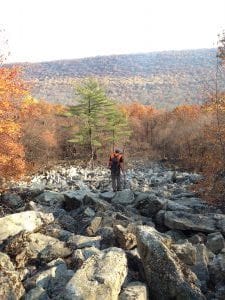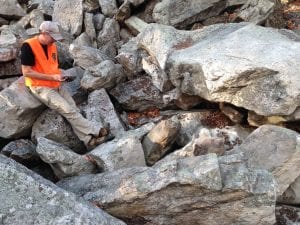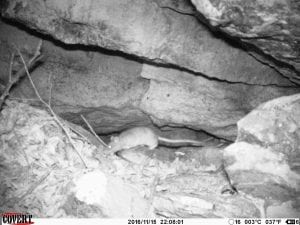On an early November morning, I loaded two large coolers filled with over 10,000 chestnuts into the car and headed out to meet with Greg Turner of the Pennsylvania Game of the Pennsylvania Game Commission (PGC). PA-TACF is collaborating on a project with the PGC to aid and observe the Allegheny woodrat. The project site is in Ellendale Forge, 11 miles north of Harrisburg, PA. Full disclosure, on this morning I know practically nothing about the Allegheny woodrat aside from the fact that relied heavily on the consistent crops of chestnuts. At the end of a dirt road we unload 100 potentially blight-resistant B3F3 chestnut seedlings. Our objective is to locate potential active woodrat sites, distribute chestnuts in concentrated piles or caches, place game cameras at each cache, and plant the seedlings in the immediate area in the hopes of providing a reliable food source in the years to come.

Allegheny woodrat habitat
Supplies are loaded into backpacks or buckets and the group heads into the forest. At first, the area is no different from most ridgetops in central PA: a mix of oak, maple, some birch, and scattered pines. A few hundred yards from the vehicles, the landscape changes and numerous large boulders can be seen protruding from the earth. The trees are smaller and more scattered when we reach a rocky cliff on the south side of the ridge. This is the home of the Allegheny woodrat, a labyrinth of cracks and tunnels — providing safety from would-be predators as well as the hot summer temperatures. Looking around the area, I see some existing American chestnut sprouts. Numerous stems appear in clumps but none are more than 20 feet in height. Even though the sprouts are infected with chestnut blight, it’s an encouraging sign for the survival of the 50 seedlings to be planted in the area.

Allegheny woodrat food station
With jobs assigned, the group divides to plant seedlings, and attempt to find signs the woodrat is present in the area. The latter job is an amusing version of whack-a-mole with heads dipping into the spaces between rocks only to pop up a moment later and relocate to the next potential cache or latrine area.
The best sites are identified, rigged with game cameras, and a rock is mounded with several thousand chestnuts. If woodrats are in the area they should find these manmade caches of nuts and redistribute them in their own caches for the winter. Creating these caches will also bring predators into the area, with confirmed visits on video of bear, raccoon, possum, and, while not a predator, even a porcupine.

Allegheny woodrat still
This process is repeated three more times. A few weeks later the caches have disappeared along with one camera a bear decided to relocate. The images from the remaining cameras confirm active Allegheny woodrat populations in the area. Future plans with the Game Commission are to continue planting potentially blight resistant American chestnuts and to design an experiment comparing the preference of different hard masts including chestnuts, acorns (white & red), and beech nuts.
*Videos of chestnut piles and critter feedings are on TACF’s YouTube channel!
